7.2 Pitched roofs
SITEWORK STANDARDS
(a) meet the Technical Requirements
(b) take account of the design
(c) follow established good practice and workmanship
Sitework that complies with the design and the guidance below will be acceptable for pitched roofs.
WALL PLATES
Roof construction details should be available on site, particularly for combination and specialist roofs.
Wall plates should be bedded to line and level using nails or straps to hold them down in accordance with the design requirements.
Wall plates should generally be in lengths of not less than 3m but shorter lengths should extend over at least 3 joists/rafters or trusses. Wall plates should be joined using half-lapped joints at corners and in running lengths. In Scotland, 100mm x 25mm wall plates should be used, in long lengths, butt jointed.
Where required, holding down straps should be fixed to the wall plate at maximum 2m centres. If the strap is not turned into a bed joint, it should be fixed to the wall with at least three screw fixings.
STRAPPING
RESTRAINT STRAPS
Restraint straps, or a restraining form of gable ladder, are required to provide stability to walls. They should be installed as shown in the design.
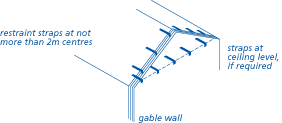
Restraint straps should be fixed to solid noggings with a minimum of four fixings of which one should be in the third rafter. The fixings should be four steel screws or four 75mm x 4mm (8 SWG) round nails.
Rafters should not be notched to make the straps flush with the rafter. Straps should go under rafters and over ceiling joists. The turn-down should be on a substantial piece of blockwork, preferably the centre of an uncut block.
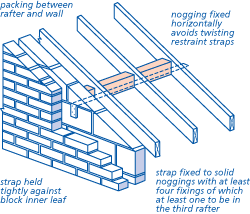
HOLDING DOWN STRAPS
Holding down straps should be used when detailed in the design. Holding down straps may be required where the:
- roof is of lightweight construction
- site is exposed.
If in doubt, check with the designer.
Straps should be at least one metre long and either screwed to the face of masonry or have a tail built into a masonry bed joint. If screws are used, a minimum of three screws are necessary, at least one of which should be located within 150mm of the bottom end of the strap. Nailing is not acceptable.
TRUSSED RAFTERS
Items to be taken into account include:
(a) storage
To avoid distortion and prevent damage, trussed rafters should be stored clear of the ground, either flat on level bearers placed under joints (for short term storage) or vertically and propped (for long term storage).
Trusses should be protected against weather to prevent corrosion of truss plates and deterioration of the timber. Ventilation should be provided.
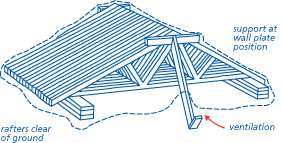
Any damaged trussed rafters or trussed rafters with loose plates should be rejected, not repaired.
(b) handling
To prevent distortion during construction, trussed rafters should be carried upright (if carried flat, bending can loosen the fasteners).
Detailed guidance on the use and handling of trussed rafters is given in the International Truss Plate Association Technical Handbook available from trussed rafter suppliers.
Detailed drawings should be available on site to show the layout of the trussed rafters, especially at hips, valleys and trimmings to chimneys, etc.
Trussed rafters should be supported only at the junction between the ceiling tie and rafter, unless specifically designed otherwise, eg as a cantilever.
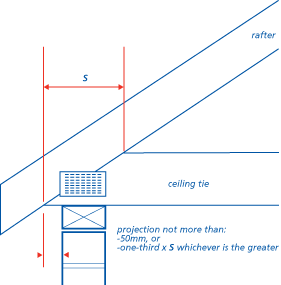
Trussed rafters should be evenly spaced and vertical. Temporary bracing should be provided to control the spacing and keep trusses vertical.
Trussed rafters should be fixed to the wall plates either:
- in accordance with the design, or
- using double skew nailing or truss clips.
Avoid damaging the metal truss plates, trussed rafters or wall plates.
The spacing or structure of trusses should not be altered without the designer's approval.
Where the width of gable ladders exceeds that of the trussed rafter centres, noggings should be provided to reduce the span of the roofing tile battens.
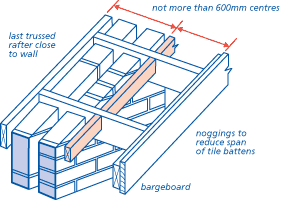
The gable ladder can be used to provide restraint to the external wall if:
- there is blocking between the last trussed rafter and the inner leaf (at a maximum of 2m spacing), and
- the soffit board is cut carefully and then fixed securely so as to restrain the outer leaf.
The roof should be braced using at least 100mm x 25mm timber. All bracing should be twice nailed with 3.35mm (10 gauge) x 65mm long galvanized round wire nails to every trussed rafter it crosses.
The minimum bracing requirements are shown in Appendix 7.2-C. Additional bracing may be needed in exposed areas. Check the design drawings for special requirements.
All bracing should be completed before starting to lay the roof covering.
Longitudinal binders should butt solidly against the wall at each end. This is most easily achieved by fixing the binder in two lap-jointed lengths.
Braces and binders, where not continuous, should have lapped joints and be nailed to at least two trusses.

The part of an attic truss which forms a floor should have strutting in accordance with Appendix 7.2-F.
TRADITIONAL CUT ROOFS
Structural timber should be marked to show its strength class (normally C16 or C24). Alternatively, evidence of species and grade should be available to determine the equivalent strength class.
The correct size of timber should be used for each member, as shown on the design drawings.
Items to be taken into account include:
(a) location of members
All members should be accurately located. Purlins and binders should be built in, where necessary. In a typical traditional roof, the basic timber members are:
- RAFTER: carries the weight of the roof finish, eg tiles, tile battens and underfelt
- CEILING JOIST or TIE: triangulates the rafters, stopping the walls and roof spreading outwards; supports the ceiling finish and any walkways, etc
- RIDGE: provides fixing and spacing for the tops of rafters
- PURLIN: supports long span rafters to prevent deflection and increase stiffness
- STRUTS: give support to purlins to prevent deflection and transmit roof loading to loadbearing structure below.
The following are extra members which may be used on large roofs:
- COLLAR: ties the roof together at purlin level
- CEILING BINDERS and HANGERS: support long span ceiling joists
- POLE PLATES: similar to purlins but used where ceiling joists are above wall plate level.
Positions of standard structural members are shown in the diagrammatic representation below:
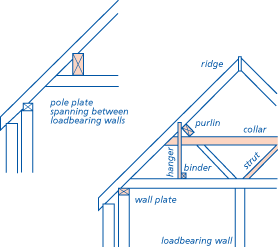
(b) prevention of distortion and overloading
The design details for sizes of timber members should be followed.
All framing should be completed before roof coverings are laid.
If a roof is not a simple triangle, all members should be fully supported and tied together. If necessary, temporary support to long span members should be used until the framing is complete.
(c) valley and hip construction
Particular care is needed in the construction of valleys and hips:
- VALLEY RAFTERS carry load from both sections of the roof. Valley rafters will need to be larger than ordinary rafters to take the extra load and to provide full bearing for the splay cut of JACK RAFTERS. (Long valley rafters may need intermediate support.)
- HIP RAFTERS provide spacing and fixing for jack rafters. They need to be a deeper section than other rafters to take the top cut of the JACK RAFTERS. Purlins should be mitred at hips, and lip cut to accept the bottom of the hip rafter.
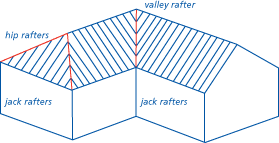
(d) dormer construction
On most dormers, the DORMER CHEEK STUDS should be supported either by a double rafter or by a double floor joist.
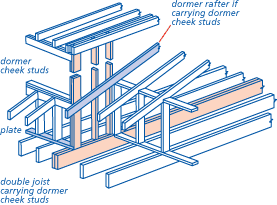
Where cheek framing does not extend to floor level, a double rafter will give necessary support to the cheek. The two rafters must be fixed together.
Trimming members around dormers should be large enough to take the extra load from the cut main roof members and dormer framing and cladding, as detailed in the design.
Dormers should be framed up so they are independent of the window frame, using a suitable lintel over the opening.
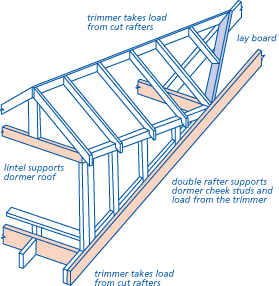
(e) jointing of members
All joints should be cut accurately to fit tightly. When they are nailed, care should be taken not to split members.
The following should be used at main connections:
- RAFTERS to ceiling joists: nailed lapped joint. The rafter should be birdsmouthed over and skew nailed to the wall plate
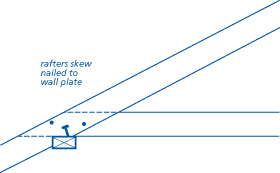
- RAFTERS to purlin: a birdsmouth joint should be used if the purlin is fixed vertically
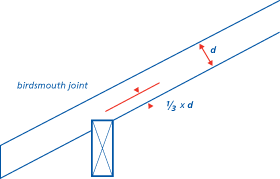
- PURLIN connections: support should be provided directly under joint or use a scarf joint. Any scarf joint should be made near a strut so that the joint supports the longer span.
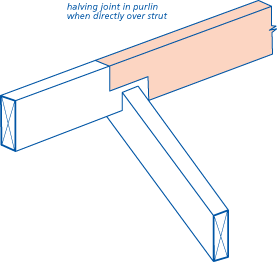
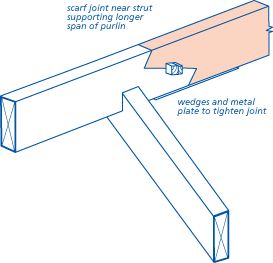
Angle ties should be used on hipped roof corners to prevent the wall plates spreading. For heavily loaded hip rafters, eg where they are carrying purlins, dragon ties or similar bracing should be used to prevent hip rafter spread.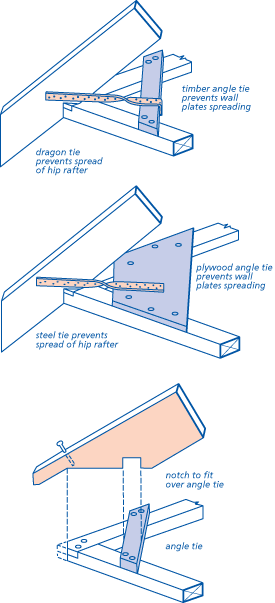
(f) strutting to cut roofs
Any part of a cut roof which forms a floor should have strutting in accordance with Appendix 7.2-F.
WATER TANK SUPPORTS
(a) the node points of trussed rafters
In trussed rafter roofs, tank stands should be supported at the node points of the trussed rafters and the load spread over at least three trusses.
Correct supports are illustrated in Appendix 7.2-D.
(b) suitable bearers in traditional cut roofs
In traditional cut roofs, tank stands should be supported as shown in the design.
FASCIAS, BARGEBOARDS AND SOFFITS
Items to be taken into account include:
(a) timber quality
Timber for external feature work should be free from waney edges, large knots and resinous pockets, splits and other unsightly defects.
(b) fixing
All joints should be cut and fixed neatly. Mitred angles and splay joints should be used to prevent exposure of end-grain. Butt joints to fascias should be splayed.
(c) treatment against decay
Where preservative treated timber is cut or planed, a liberal brush coating of preservative should be applied.
All untreated timber that is to be painted should be knotted and primed all round before fixing. When timber requires a stained finish, one coat of stain should be applied before fixing.
ROOFING MATERIALS
Items to be taken into account include:
(a) ventilation
All roof voids should be ventilated to prevent condensation problems.
Ventilation openings where the least dimension exceeds 10mm should be protected with mesh to prevent entry of birds, etc.
Where proprietary eaves ventilators are used, they should be fixed in accordance with the manufacturer's instructions.
Ventilation should be provided on opposite sides of the roof space, equivalent to a continuous gap of the width shown in the following drawings: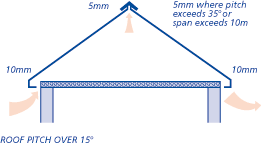

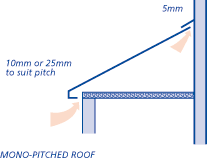
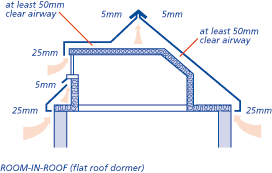
Where the ceiling is partially or completely sloping and the ventilation path is blocked, the roof void should have additional ventilation openings immediately below and above the block.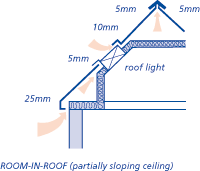
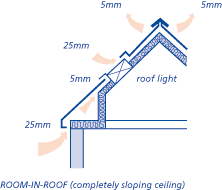
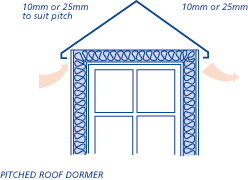
(b) underlays
Horizontal laps should be as follows:
| Pitch | Minimum horizontal lap (underlay not fully supported) |
| Less than 15° | 225mm |
| 15° to 34° | 150mm |
| 35° and above | 100mm |
Vertical laps in the underlay should occur only over rafters and be securely fixed. Where the pitch is below 30°, the underlay should be supported at eaves level by a tilting fillet. The underlay should be dressed into the gutter and pulled tight to ensure there are no troughs to retain water.
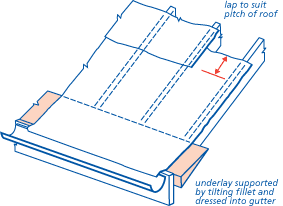
The underlay should extend over the ridge.
A strip of underlay, at least 600mm wide, should be laid over hips and above the underlay to the main roof.
At valleys, a similar strip should be laid under the main roof underlay and held down by the valley battens, where used. The main roof underlay should be dressed over the valley battens.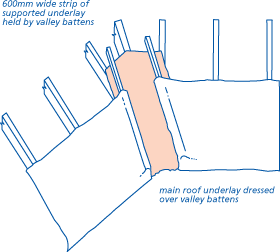
The underlay should be turned up at least 100mm at all abutments to prevent rain and snow being blown into the roof space.
Where necessary to protect the heads of timber features, the underlay should extend 50mm beyond gable walls, bargeboards, etc.
Particular care is needed where pipes project through the underlay. Torn underlay around pipes can lead to the ceiling becoming wet and stained. Cut a small cross in the underlay and sleeve over the pipe so that the tongues turn up.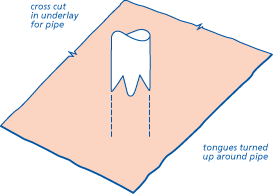
(c) battens and counter battens
Battens should be set out in straight lines, parallel to the ridge and to the gauge required by the tile or slate. The lap should not be decreased because this would reduce weathertightness. The lowest batten should be fixed so that the tile projects halfway across the gutter.
Battens should be:
- at least 1.2m long
- supported by at least three rafters
- butt jointed on a rafter, and
- nailed to every rafter.
Batten ends should be cut square and nails skew driven on each side of the joint. Not more than one batten in four should be joined over any one truss or rafter.
Where underlay laps are not under a batten, an extra batten should be used to prevent the underlay lap opening due to wind uplift.
Battens on rigid sarking boards should be supported on counter battens to allow free drainage of any water that may reach the underlay. Counter battens should be fixed through to the rafters and not to the sarking boards alone. Battens should be fixed through counter battens to rafters.
Battens should be fixed with cut or wire nails. The nail shank can be smooth, annular ringed or helically threaded. Nails can be steel or aluminium. In coastal areas, steel nails should be hot dip galvanized.
(d) slates and tiles
Slates should be fully nailed over the whole roof.
The design should specify the number of fixings for clay and concrete tiles. Tables 2 and 3 of Appendix 7.2-B contain minimum fixings for tiles. Additional nails and clips may be necessary in accordance with the design.
Ridge and hip tiles, for a distance of at least 900mm from the face of rigid masonry supports such as gables, abutments and separating walls, should be mechanically fixed.
Careful setting out makes the actual tiling process faster and will influence the finished appearance on the roof. It helps to avoid problems such as unequal overhangs at verges and often makes it possible to avoid excessive tile cutting at abutments, chimneys and similar obstructions.
For plain tiles and slates, joints should be slightly open. This allows some flexibility in setting out. Interlocking tiles have a tolerance of about 3mm in the joint, giving sufficient latitude over the whole roof width to avoid tile cutting.
Bottom edges of slate and plain tile roofs should be finished with an under-eaves course.

Purpose-made tile-and-a-half, or half-tiles, should be used at verges. Cut tiles at verges are not acceptable.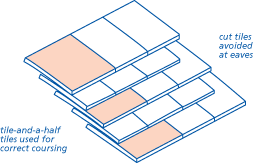
Tiles to be bedded on mortar should be wetted first. Allow the surface water to drain before fixing. Substantial thicknesses of mortar bedding may be needed, eg beneath a bold roll tile, to give it body. Mortar should normally be 1:3, cement : sharp sand.
(e) other roof coverings
When using the following materials, the detailing and workmanship should follow the design and recognised good building practice:
- sheet metal roofing including lead, copper and zinc
- thatch
- cedar shingles.
Thatching should be as recommended by the Thatch Advisory Service or other appropriate authority in accordance with Technical Requirement R3.
FLASHINGS AND WEATHERINGS
Items to be taken into account include:
(a) eaves
Tiles or slates should overhang to the centre of the gutter. For slates or plain tiles, an under-eaves course should be used.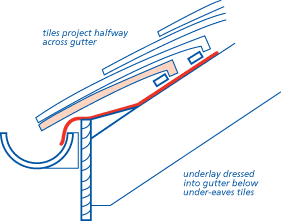
To prevent the underlay sagging at the eaves and forming a water trap behind the fascia, it is recommended that the underlay is supported by a continuous fillet. Where the pitch is below 30°, a continuous fillet should always be used. Plain tiles are unsuitable for pitches less than 35°.
(b) verges
All verge tiles and slates should be bedded on an undercloak. Alternatively, proprietary dry verge systems should be fixed in accordance with manufacturers' recommendations.
Where a bargeboard is used, the undercloak should be securely nailed to a true line, projecting 40mm to 50mm beyond the bargeboard. If laid directly on masonry, the undercloak should be bedded on 1:3 cement : sharp sand with plasticiser mortar struck off flush with the external surface of the wall.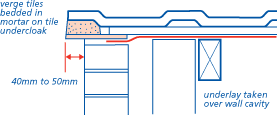
The undercloak should lap the roof underlay but not tilt inwards. Verge slates or tiles should be bedded on the undercloak and the 1:3 cement : sharp sand with plasticiser mortar struck off smoothly and cleanly. Interlocking single lap tiles should be secured with clips nailed in position at the tile lap, as well as bedded in mortar.
(c) ridges and hips
Ridge and hip tiles are bedded in 1:3 cement : sharp sand with plasticiser mortar or mechanically fixed using a proprietary dry ridge fixing system following the manufacturer's instructions. The method shown in the design should always be used.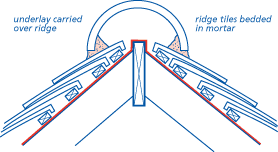
Where bedded in 1:3 cement : sharp sand with plasticiser mortar the following tiles should also be nailed:
- bonnet hip tiles
- end ridge tiles
- ridge tiles over separating walls
- mono-pitch ridge tiles.
Where half-round tiles are used at hips, they should be supported at the base of the hip by a galvanized hip iron.
(d) valleys and hidden gutters
Construction should be adequate in relation to:
- depth
- width
- undercloaking
- pointing
- adequate support
- pitch.
Valleys should be formed using one of the following:
- valley coursing tiles (plain tiles)
- valley trough tiles (interlocking tiles)
- non-ferrous metal
- a proprietary system.
Where roof coverings are of plain tiles or slates, laced and swept valleys may be used or, alternatively, a mitred valley with soakers.
The pitch of a valley is less than the pitch of the main roof. Where tiles are to be used for valleys, the valley pitch should be not less than the minimum permissible pitch given in Table 1 of Appendix 7.2-B.
VALLEY USING VALLEY TILES
In roofs with plain tiles, purpose-made valley coursing tiles should be used. Adjacent roof tiles should be cut neatly to form a smooth junction, preferably cutting from tile-and-a-half tiles.
For single lap interlocking tiles, purpose-made valley trough tiles should be supported by gutter boards. Roof tiles should be cut to the correct rake. Mechanical cutting gives a neater appearance than hand cutting. The tiles should be bedded in mortar, leaving a minimum 100mm wide channel (125mm minimum for pitches below 30°).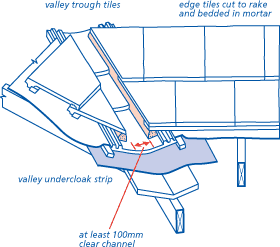
LEAD-LINED VALLEY
Lead-lined valleys should be Code 4 (colour coded blue) or Code 5 (colour coded red) and supported on gutter boards of 19mm thick marine ply or as specified. Lead in valleys should be laid in lengths not exceeding 1.5m and be lapped 150mm at each length. Tiles should be cut and bedded as for valley trough tiles except that the mortar should be bedded on an undercloak (for example slate) to prevent direct contact between the lead and the mortar.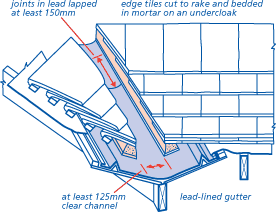
PROPRIETARY SYSTEMS
Proprietary gutter or valley systems should be fixed in accordance with the manufacturer's recommendations.
(e) flat roof intersection
Where a flat roof adjoins a pitched roof, or where valleys or gutters occur, the waterproof membrane should be carried up under the tiling to a height of 150mm above the flat roof, valley or gutter and lapped by the roofing underlay.
The lowest course of tiles/slates should not touch the roof membrane.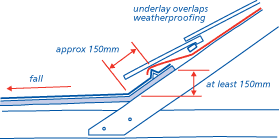
Note
Where the flat roof is over a dormer, it is recommended that the flat roof should be designed and constructed with a fall to the front or sides.
Flat roofs should comply with Chapter 7.1 'Flat roofs and balconies' (Sitework).
(f) abutments
All abutments should be weatherproofed using non-ferrous metal flashings. Lead flashings should be at least Code 4 (colour coded blue), while soakers are normally Code 3 (colour coded green). Normally, lead flashings should not exceed 1.5m in length, with laps of not less than 100mm.
Flashing should be tucked into a mortar joint or chase 25mm deep and at least 75mm above the tiling level and lead wedged in place. The joint should then be pointed in cement mortar of 1 : 3, cement : sharp sand.
Cavity trays should be linked to the flashing to prevent water penetrating into an enclosed area where a:
- flat or pitched roof over an enclosed area abuts a wall
- balcony abuts a wall.
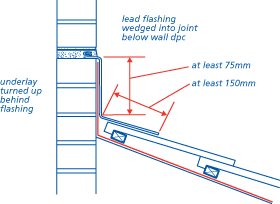
Where a pitched roof abuts the wall at an angle, a stepped cavity tray linked to a stepped flashing should be used.
Stepped flashings should be cut from a strip at least 150mm wide.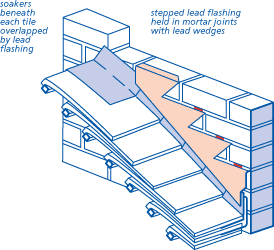
(g) projections through the roof
A purpose-made one-piece flashing and upstand should be used around pipes projecting through the tiling.
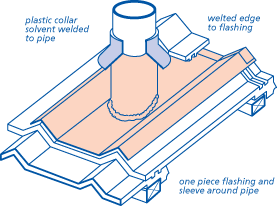
Chimney flashings should link with the chimney dpc trays. An example is shown below.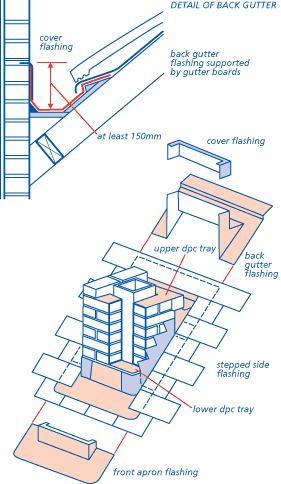
(h) changes in roof slope
Flashings or soakers should be used where there is a change in roof slope of 5° or more, eg at mansards and sprockets.
A saddle flashing should be used where a ridge meets the main roof.
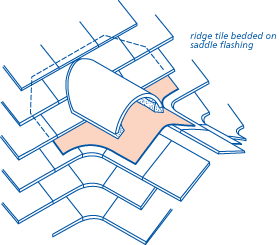
FIRESTOPPING
Firestopping and cavity barriers should be provided:
- at junctions between cavities
- above separating walls
- within boxed eaves of separating walls.
The separating wall should stop about 25mm below the top of adjacent roof trusses.
A soft fire-resistant packing, such as mineral wool, should be used to allow for movement in roof timbers and prevent 'hogging' of the tiles.
A cavity barrier should be provided within boxed eaves. The cavity barrier should be wire reinforced mineral wool blanket, at least 50mm thick, nailed to the rafter and carefully cut to shape to fully seal the boxed eaves.
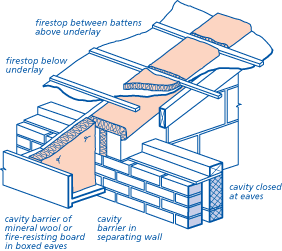
THERMAL INSULATION
To avoid condensation forming in the roof space ensure that:
- cross ventilation of the roof is provided in accordance with the design
- insulation does not block the ventilation path at eaves level
- insulation is laid over the whole loft area, including the wall plate
- there are no gaps in the insulation.
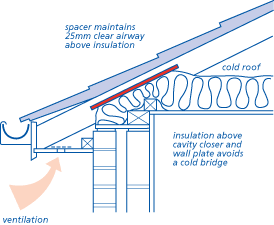
The amount of moist air entering the loft space from the dwelling should be controlled by:
- draughtstripping the loft hatch or using a proprietary loft hatch
- ensuring that the hatch is heavy enough (or suitably fixed) to compress the draught seal
- sealing gaps where services pass through the ceiling.
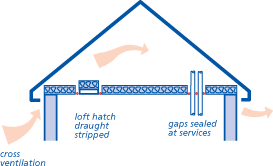
The guidance above will assist in reducing the risk of condensation occurring but is not acceptable as an alternative to cross ventilation of the roof space.
To reduce the risk of freezing and condensation on pipework, the following precautions should be taken:
- place roof insulation above and around water tanks but not below them
- locate water pipes below the main roof insulation whenever possible
- insulate all water services above the main roof insulation, including cisterns and vent pipes.
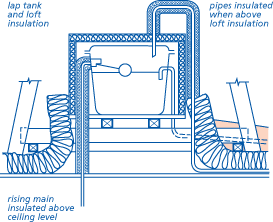
It is recommended that the cold rising main be insulated above ceiling level even if it is below the main roof insulation (condensation that forms on uninsulated cold water pipes located below the main roof insulation can result in damage to ceilings and decorations).
ROOF DRAINAGE
Items to be taken into account include:
(a) fixing and jointing gutters and downpipes
Rainwater gutters and downpipes should be fixed in the positions indicated by the design using the correct type of fittings for internal and external angles, outlets, etc to ensure efficient drainage of the roof. Gutters and downpipes should be supported and jointed in accordance with the manufacturer's recommendations.
(b) falls
Gutters should be laid with sufficient fall towards the outlet, unless designed to be flat, and be provided with stop ends.
(c) satisfactory outfall
If a downpipe discharges above ground level or above a drainage gully, a shoe should be fixed to the end of the pipe to prevent walls becoming saturated.





















